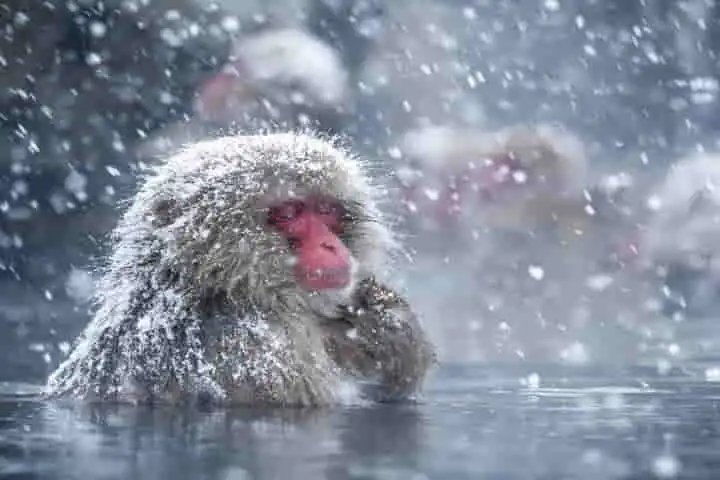Monkeys, humankind’s closest relative, have always impressed with their intelligence and ingenuity and yet another example of this has come to light through a recent study, according to an article in scitechdaily.com.
Inhabiting one of the globe’s coldest areas in Japan, snow monkeys have managed to live and survive the harsh winter by “going fishing”, that is lifting out creatures alive, including the brown trout, out of rivers of Japan and consuming them alive, states this new study.
Native of the main Japanese islands, except Hokkaido, the snow monkey or the Japanese macaque Macaca fuscata is the non-human primate living most northerly. With the Kamikochi area of Chubu Sangaku National Park located in the Japanese Alps covered in snow, these creatures are confronted with scarcity of their preferred food.
Also read: Vulture bees of Costa Rica feast on meat
Faced with such adverse conditions, the monkeys running low on energy are bound to die of starvation but the streams that are fed by groundwater with a constant temperature of 5 degrees Celsius, thus being accessible to the animals to find alternate food which is a live.
The findings of this study done by an international research team that was led by the experts of University of Birmingham, was published in Scientific Reports this week. This is the first scientific paper that has reported about these Japanese macaques definitively eating animals of freshwater, including the brown trout.

In the past it was observed that snow monkeys were opportunistic as they managed to grab the fish which was either being dried or had washed up on the beaches but now it was found their closely-related species were consuming freshwater fish.
The scientists while examining their fecal samples found brown trout which they feel were caught by them along the stream margin in the shallow pools.
Researchers used metabarcoding of fecal samples of these monkeys to find out about their diet during the winter and uncovered that these creatures also ate mollusks and riverine insects. These provided additional food sources to help them to tide over the cold winter.

Commenting on the study, Alexander Milner, University of Birmingham’s Professor of River Ecosystems said: “Japanese macaques have a wider winter home range when food resources are scarce, but Kamikochi lies in a deep valley where they cannot cross the mountains. Population density is exceptionally high and macaques must overwinter in an extremely harsh environment.” Milner led this study team.
The professor went on to add: “These larger populations create additional stress for surviving winter, but an abundance of groundwater upwellings and hot spring inputs from active volcanoes ensures many streams flow without ice cover allowing easy access to the monkeys. With high numbers of freshwater animals in its rivers and streams, the Kamikochi area may be the only environment in Japan where the topographical, geological, and meteorological conditions allow Japanese macaques to supplement their winter diet in this way.”
Also read: Birds lose weight, increase wing span in response to climate change
Evidence of freshwater insects in the monkeys’ fecal samples, including that of aquatic insect larvae and nymphs was also found. During the summer, the terrestrial insects do comprise a major source of food for the macaques but this was the first instance of finding nymphs and aquatic insect larvae in their diet.
Incidentally, December 3, that is today, is celebrated as the World Japanese Macaque Day. It was on this day in 1948 that Kinji Imanishi of Kyoto University and his students first visited Koshima Island to study wild Japanese macaques. This marked the beginning of primatology in Japan and Imanishi founded the Japan Monkey Centre.




















